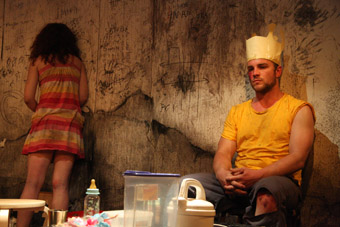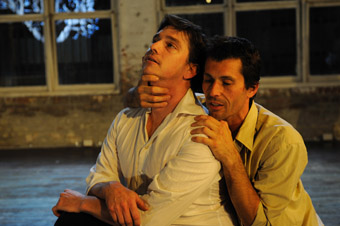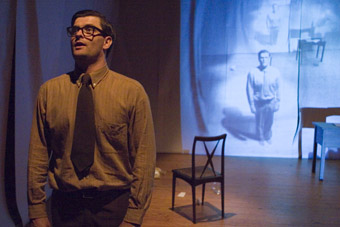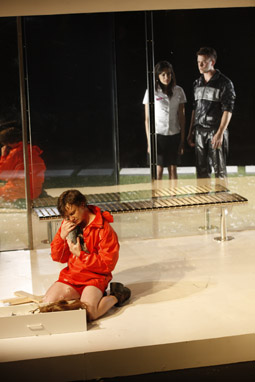wunderkind mysteries
john bailey: melbourne performance

Sophie Mathisen, Andrew Dunn, Life is a Dream
photo Daisy Noyes
Sophie Mathisen, Andrew Dunn, Life is a Dream
IT’S TEMPTING TO STATE THAT 2009’S CLOSE WILL BE REMEMBERED FOR THE PROVOCATIVE, NATION-SPANNING DEBATES SURROUNDING GENDER DISPARITY IN THEATRE WHICH CROSSED MAINSTREAM PRESS, THE BLOGOSPHERE, SMALL PRESS AND FOYER CONVERSATION. THIS MIGHT BE WRONG FOR TWO REASONS: FIRSTLY, THESE DEBATES ARE FAR FROM OVER, AND TO CONSIGN THEM TO HISTORY WOULD BE GROSSLY NEGLIGENT. BUT SECONDLY, SADLY, THERE’S AN EQUAL CHANCE THAT THESE DEBATES WILL SOON BE HARDLY REMEMBERED AT ALL.
That said, I’m not going to try to address the entirety of this complex debate here. I do want to tackle one tiny corner of the canvas, however: the notion of the (male) wunderkind. It was a topic raised by a number of voices last year—the sense that those who push our theatre in the most exciting new ways are almost invariably youthful white males. Of course this is a fallacy. But the wunderkind phenomenon is no less real for being a myth, and an enduring one at that. The Koskys, Kantors and Andrews were never the only artists working at the vanguard, but they have reached a national status that affirms this mythmaking exercise and a younger crop are being hailed as their successors.
Four very different productions which appeared in late 2009 provide ways of thinking through this dynamic. Simon Stone is one of the touted heirs to the wunderkind title, but his B.C. saw the crown resting uneasily; Daniel Schlusser’s Life is a Dream made one wonder why he has never been positioned in the same category; James Saunders’ Harry Harlow emphasised collaboration rather than individual artistry; and Bagryana Popov’s Progress and Melancholy was a reminder that innovation has nothing to do with gender.
Schlusser and Popov have both been developing distinct aesthetics for some time now, but haven’t received the same kind of attention afforded someone like Stone. Life is a Dream was a rich, difficult production, infuriating to some and unforgettable to most. The complexity of its aesthetic sensibility made it, for me, one of the most rewarding experiences of the year. Schlusser stripped back Pedro Calderón de la Barca’s 15th-century play to a raw core of power relationships and plot mechanics, then had a cast of bedraggled wastrels act out this excoriated drama as an infernal punishment. The conditions within which these performers found themselves have been compared to Big Brother (both Orwell’s nightmare and the reality TV show) but the situation seemed to me more thickly existential rather than simply allusive. The actors forced one another into cruel games of torture, humiliation and betrayal; that the play they eventually began to perform was just another monstrous game is vital. De la Barca’s drama is very much concerned with freedom and predestination; Schlusser’s direction gives this greater resonance by creating a performance space that highlights the absurd limitations ‘theatre’ imposes on its participants.

Todd MacDonald, Christophe Le Tellier, Progress & Melancholy
photo Paul Dunn
Todd MacDonald, Christophe Le Tellier, Progress & Melancholy
Popov’s Progress and Melancholy was a more playful attack on similar ideas—inspired by Chekhov’s The Cherry Orchard, it took a freewheeling, libertarian approach to adaptation. Standup comedy, dance and live music appeared unexpectedly; various narrative threads were given heightened prominence while others were almost done away with entirely. Popov herself gave audible direction from one side of the audience bank, and this sense of liveness underscored much of the production, where individual performances frequently took on aspects of improvisation and emotional immediacy.
The effect was quite other to that produced by Life is a Dream. Schlusser’s production created violent chaos within a tightly defined space of rules; Popov’s seemed more interested in challenging rules and the result was a strangely orderly experience. Its unruliness seemed merely sporting, making for an undeniably enjoyable work that never quite went beyond its own ephemerality.

James Saunders, The Harry Harlow Project
photo John Sones
James Saunders, The Harry Harlow Project
James Saunders’ The Harry Harlow Project was another fascinating experiment which quite literally focused on the laboratory as a metaphor for freedom and control. Taking as its subject the notorious behavioural scientist whose pioneering experiments on primates deeply influenced 20th-century psychology on infant-rearing, attachment and mental illness, it shied away from biography in favour of a more impressionistic portrait of a troubling figure. Trapped within a cold, clinical room and beset by physical tics and psychological compulsions, the confines of the stage here came to represent the solipsistic inwardness of the character unable to escape the limits of his own existence.
But while Harlow’s lot is to be eternally caged with his own demons, Saunders has ensured that the production itself is not the result of a single vision—rather, much of the work’s shape is defined by his collaborators. Martyn Coutts and Kelly Ryall provided live video and aural components to Saunders’ solo performance, where projected monkey footage and fascinating sequences wherein Harlow engages with ghostly doubles of himself or his shadow offered some of the most striking moments. Brian Lipson’s direction, on the other hand, felt less disciplined and at times introduced a less integrated, more self-conscious tone to the work.

Dylan Young, Nicole Da Silva, Ashley
Zukkerman, B.C., The Hayloft Project
photo Jeff Busby
Dylan Young, Nicole Da Silva, Ashley
Zukkerman, B.C., The Hayloft Project
Simon Stone has been taking The Hayloft Project in encouraging new directions in the past 12 months. Initially a company indelibly stamped with his own creative mark, 3xSisters saw the director teaming up with two others to take on another Chekhov classic, while the wonderful Yuri Wells was essentially developed Stone-free (RT94, p8). This expansion of Hayloft’s boundaries has substantially enhanced the range of work we can expect from the company.
B.C. saw Stone back at the directorial helm, but here he took on an original script rather than setting his sights on reinventing an established work. Rita Kalnejais’ writing is perhaps the least confident ingredient in the mix, though an outstanding cast mostly made up for some structural failings in the narrative.
The work performs a contemporary retelling of the Christian story of Mary and Joseph: the pair are disaffected teens in a suburban Australia, the archangel Gabriel is Mary’s intellectually disabled brother. These religious notes are only one of B.C.s layers, however, and far more compelling are the less forced details of quotidian wonder that permeate the mythic overtones. Joseph’s gradual shift from clichéd tracksuit-wearing thug to self-questioning lover is deftly handled, while Mary’s parents are provided thick and engaging narrative arcs of their own.
What can these varied productions tell us about that old wunderkind thing, then? For one, they suggest that the kinds of dense, textured theatre that shifts away from textual primacy maintains a meta-theatrical self-awareness and incorporates extra-theatrical modes of performance are being created by all sorts of people all over the place. Trying to find applicable terms for this kind of theatre (the post-dramatic, the spectacular, the postmodern, the cross-platform) seems a bit unnecessary, since these diverse works aren’t simply a trend or movement. They’re an indication of where performance is at right now in this country.
Secondly, they hint at the way the great authorial director is always less responsible for a production’s successes (and failings) than the myth would lead us to believe. The finest directors in Australia are the ones with the best collaborators. However dictatorial and demanding a director’s public face may be, they’re still at the mercy of designers, writers, performers and countless others who will shape the thing that wears their name.
So why are particular men elevated to a particular status as directors? This isn’t to fault people such as Stone, or Benedict Andrews or Simon Strong or Matthew Lutton, who are all very talented and knowledgeable theatremakers. But they’re not alone, and they’re not Olympian in their abilities. Perhaps it’s just that among the many, many first-rate artists in the country, we need a few names to stick out as ones to watch; a combination of media laziness and audience acceptance. Is that really good enough?
Life is a Dream, director Daniel Schlusser, performers George Banders, Brendan Barnett, Johnny Carr, Andrew Dunn, Julia Grace, Sophie Mathisen, Vanessa Moltzen, Sarah Ogden, Josh Price, design Marg Horwell, lighting Kimberly Kwa, composer Darrin Verhagen, The Store Room, Nov 20-29; Progress and Melancholy, director Bagryana Popov, performers Todd Macdonald, Natasha Herbert, Majid Shokor, Christophe Le Tellier, Paea Leach, Sara Black, design Adrienne Chisolm, lighting Richard Vabre, composer Elissa Goodrich, Fortyfivedownstairs, Nov 19-29; The Harry Harlow Project, writer, performer James Saunders, director Brian Lipson, composer Kelly Ryall, video artist Martyn Coutts, dramaturg Kate Sulan; Full Tilt, Fairfax Studio, Arts Centre, Nov 26-Dec 5; The Hayloft Project, B.C., writer Rita Kalnejais, director Simon Stone, performers Tyler Coppin, Nicole Da Silva, Margaret Mills, Yesse Spence, Dylan Young, Ashley Zukerman, design Claude Marcos, lighting Kimberly Kwa, sound design Stefan Gregory; Full Tilt, Black Box, Arts Centre, Melbourne, Nov 30 – Dec 9, 2009
RealTime issue #95 Feb-March 2010 pg. 41






